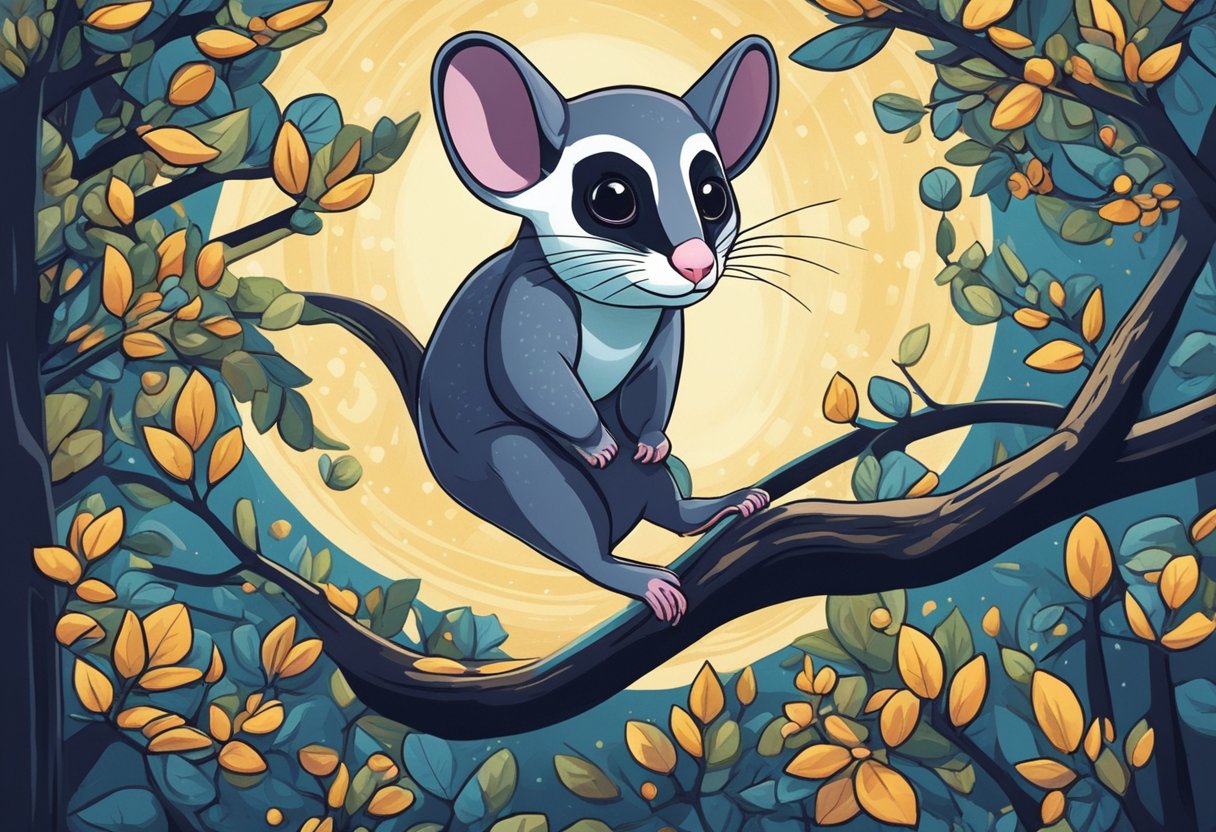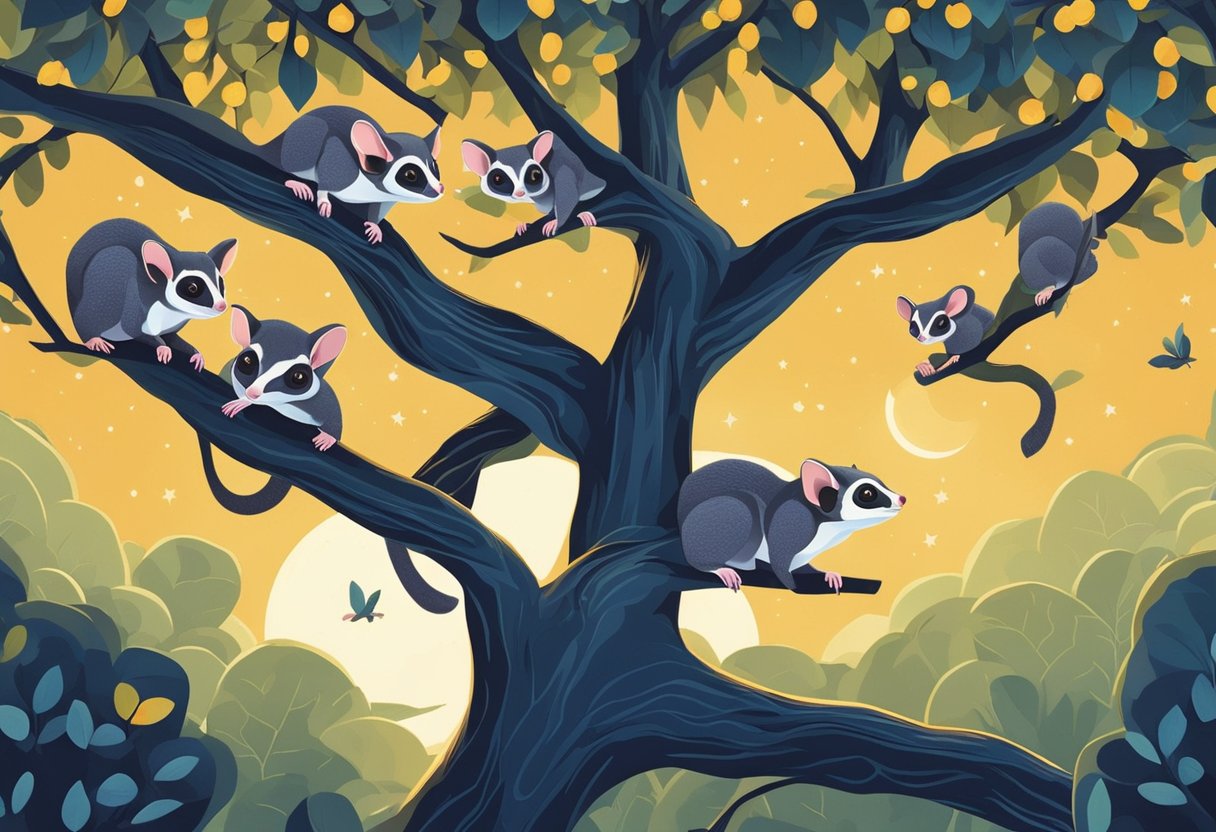
When it comes to understanding the fascinating world of sugar gliders, one cannot overlook their intriguing nocturnal habits. As small marsupials originally from the rainforests of Australia and Indonesia, sugar gliders have distinctive activity patterns that are firmly rooted in their biology and environment. Nocturnal behaviors of sugar gliders are not merely a random preference, but crucially align with their survival strategies.
At first glance, sugar gliders’ nocturnal lifestyle may seem unusual to us, as it is diametrically opposite to human activity patterns. However, understanding sugar glider activity patterns, particularly their night-time behaviors, can offer riveting insights into their survival mechanisms, adaptability, and unique evolutionary adaptations that facilitate life after sundown. As we delve deeper into the realms of these nocturnal wonders, we embark on a captivating journey to discover how their biology, lifestyle, and natural instincts inextricably tie into the cover of darkness.
Peering into the Night: The Nocturnal Lifestyle of Sugar Gliders
A nocturnal lifestyle comprises a large part of the existence of these fascinating creatures known as sugar gliders. The benefits of sugar gliders’ nighttime behavior are multi-fold, playing a vital role in their survival strategy.
This might raise questions.”Why are sugar gliders nocturnal?” or “What advantages does being active at night bring?” To delve into these questions, we need to turn back the clock and trace the evolution of these intriguing marsupials.
Biologically, sugar gliders are primed for nocturnal activities. Over centuries of adaptation, these creatures have developed an acute sense of hearing, superior night vision, and other sensory adaptations that gear them up for their twilight lifestyle. This enables them to navigate effortlessly and thrive in the nighttime environment while most predators are asleep, thus minimizing their threats.
Sugar Gliders’ Sensory Adaptations
| Adaptation | Description | Benefits |
|---|---|---|
| Superior Night Vision | Sugar gliders have large, forward-facing eyes that allow them to gather as much light as possible. | Ability to forage and navigate effectively at night. |
| Acute Sense of Hearing | Their sharp ears can detect even the slightest rustling of insects or plants. | Detection of potential prey or approaching predator in the dark. |
| Specialized Diet | Sugar gliders primarily feed on nectar, sap, insects, and small vertebrates – resources abundantly available at night. | Access to an abundant food supply when competition is low. |
Ultimately, the nocturnal behavior of sugar gliders is an elegant dance of evolution, honed by millions of years of adaptation. As one discovers more about sugar gliders’ nighttime behavior, it becomes clear how much their lives revolve around the cloak of darkness. Their superior senses, dietary habits, and social structures all align to make the most of the night – a testament to the sugar glider’s nocturnal lifestyle.
Decoding the Dark: Sugar Glider Behavior at Night
Nocturnal by nature, sugar gliders are primed to engage in a host of fascinating activities once the sun goes down. Their nocturnal behavior often intrigues many pet owners, scientists, and animal enthusiasts alike. This section will delve into the realms of the night to explore how sugar gliders behave and what activities they partake in when darkness shrouds the world.
Common Nighttime Activities of Sugar Gliders
Distinguished by an uncanny ability to adapt and thrive in the dark, sugar gliders indulge in multiple activities that characterize their sugar glider behavior at night. Gliding from tree to tree, they are agile climbers and avid foragers. Contrary to their calm demeanor during the day, they become hyperactive at night with bouts of energetic play, socializing and nest-building. Sugar gliders are highly social creatures and much of their nocturnal behavior is centered around interacting with members of their colony.
Foraging and Feeding: Understanding Their Night Habits
Their nights are not all play, as a significant portion of the sugar glider nocturnal behavior revolves around finding food. They are opportunistic omnivores, feeding on a diet that primarily comprises insects, small vertebrates and sap from trees. As they navigate through the darkness, sugar gliders use their acute sense of smell and hearing to locate sustenance, often traveling great distances in their quest for food.
Sugar Gliders’ Interaction with Their Environment After Dusk
Understanding the nocturnal behavior of sugar gliders stretches beyond their activities, providing insight into their relationship with their environment. Nestled high up in the trees, sugar gliders mark their territories using scent glands, thereby creating an intricate mosaic of scented trails which also aid them in navigation. Alongside, they employ stealth and agility to evade predators and ensure their survival after dusk. These fascinating behavioral adaptations paint a compelling image of their life in the wild, shedding light on how they use their natural skills to flourish under the cover of night.
The Science of Sleep: Exploring Sugar Gliders’ Sleep Cycle

In the fascinating nocturnal world of sugar gliders, a profound understanding of their sleep cycle can profoundly inform the caring guidelines for these petite creatures. Let’s uncover the inherent intricacies of the sugar gliders sleep cycle and the importance of nocturnal habits to these intriguing animals.
The Importance of Darkness: Sugar Gliders and Their Circadian Rhythms
Like many nocturnal animals, sugar gliders function rhythmically to a cycle referred to as the circadian rhythm. This internal clock shapes the sugar glider’s behaviors and actions according to the natural day-night cycle. It heavily emphasizes their nighttime activity and consequently their rest period during the day.
- Circadian Rhythm: Sugar gliders are biologically programmed to be active during nights and get their rest during daytime hours. Their instinctive sugar glider nocturnal habits are a result of their receptive circadian rhythm molded by hundreds of years of evolution.
- Impact of Darkness: The incorporation of darkness is an essential component in a sugar glider’s environment. It helps maintain their natural sleep cycle and enhances their comfort, health, and well-being.
How Light Affects the Sleep Patterns of Sugar Gliders
Artificial light emerges as a disruptive factor for the sugar gliders sleep cycle. Here, we delve into understanding how the sleep patterns of sugar gliders can be skewed by exposure to light:
- Light Intrusion: The intrusion of light during their rest hours messes with the natural, inborn activity patterns of sugar gliders. This can lead to imbalances in their sleep cycle, causing them stress and possibly leading to health complications over time.
- Creating an Ideal Environment: To keep the sugar glider’s sleep-wake cycle undisturbed, it becomes crucial to replicate their natural environment as much as possible. This includes maintaining a dark ambiance during their daytime sleep period and minimizing artificial light intrusion.
| Aspect | Description |
|---|---|
| Circadian Rhythm | Biolgical clock dictating nocturnal activity and daytime rest |
| Role of Darkness | Crucial in maintaining sugar glider’s sleep cycle and overall well-being |
| Light Impact | Can disturb the sleep cycle, causing stress and potential health issues |
| Creating a Suitable Environment | Important in preserving natural sleep-wake pattern, involves minimizing artificial light |
Deep-dive research and understanding sugar glider activity patterns help us respect and cater to their nocturnal habits efficiently. In recreating their natural habitat—be it the nighttime activity or the daytime slumber—we contribute towards their health and longevity in a home care setting.
Adapting to the Rhythms: Care Tips for Nocturnal Pets
Living with a nocturnal pet such as a sugar glider is a unique experience that requires its own set of care and management practices. By understanding the nocturnal behavior of sugar gliders, and tailoring their care accordingly, owners can ensure a healthy and enriched life for these fascinating small marsupials.
Creating a Suitable Environment for Nighttime Activity
Creating an environment that mirrors the natural conditions of a sugar glider’s nocturnal lifestyle is paramount to their well-being. Suitable cage setups including larger enclosures with numerous branches, toys, and hiding spots can stimulate their nighttime activity. Dietary recommendations should align with their natural feeding patterns during the night. This would mainly include insects, nectar, and fruits. By emulating the sugar glider’s natural environment and diet, owners can encourage healthier behaviors and contribute to their overall well-being.
Understanding and Managing Nocturnal Noise and Movement
Navigating disruptions caused by the noise and movement of sugar gliders during their night activity is crucial for a harmonious household. Sound-proofing the room or having the cage in a separate space can effectively mitigate the noise. White noise machines or nature soundtracks can also mask the sugar gliders’ nocturnal noises. Meanwhile, understanding their behavior at night helps to accept their activity patterns and avoid misinterpreting them as signs of distress or illness. All the strategies should be utilized in respect of their natural behaviors and in consultation with a qualified veterinarian.
Learning more about sugar gliders’ nocturnal habits can transform the adventure of keeping these unique pets into a rewarding journey. Utilizing resources from experienced sugar glider owners and veterinary advice is a great way to gain robust knowledge and guidance. Therefore, seeking education on their care is equally important for the well-being of these incredible nocturnal creatures.
FAQ
What are some common examples of nocturnal behavior in sugar gliders?
Sugar gliders are most active during the night, engaging in activities such as foraging for food, playing, socializing and building nests. Their superior night vision and acute sense of hearing are essential tools for ensuring their survival in the wild during these hours.
Why is understanding nocturnal behavior important for sugar glider care?
Recognizing and respecting the nocturnal habits of sugar gliders is key to their well-being in a home setting. Providing an environment that aligns with their natural sleep cycle and night-active lifestyle will help avoid potential health and behavioral issues linked to disrupting their circadian rhythm.
How do sugar gliders find their food at night?
Sugar gliders have developed a keen sense of smell to locate flowers and ripe fruits in the dark. They are also agile climbers and excellent gliders, allowing them to move efficiently between trees without touching the ground where predators may lurk.
What are the sleep cycle characteristics of sugar gliders?
Sugar gliders follow a nocturnal lifestyle, sleeping in their nests during the day and remaining active, feeding, and socializing at night. Their sleep-wake cycle, known as the circadian rhythm, is regulated by light cues such as sunrise and sunset.
How can I create an ideal environment for my nocturnal sugar glider?
To mimic a sugar glider’s natural habitat, ensure their enclosure is quiet and dark during the day to enable restful sleep. At night, provide opportunities for feeding, play and social interaction. Ensuring a consistent light-dark cycle can support their natural rhythm, promoting health and well-being.
Are sugar gliders noisy at night?
Sugar gliders can be quite active at night, making a variety of sounds as part of their normal communication. They may squeak, crab, or hiss as part of their natural nightly activity. These noises can be minimized by ensuring your sugar glider is well cared for, stimulated and has appropriate feeding schedules.

Leave a Reply